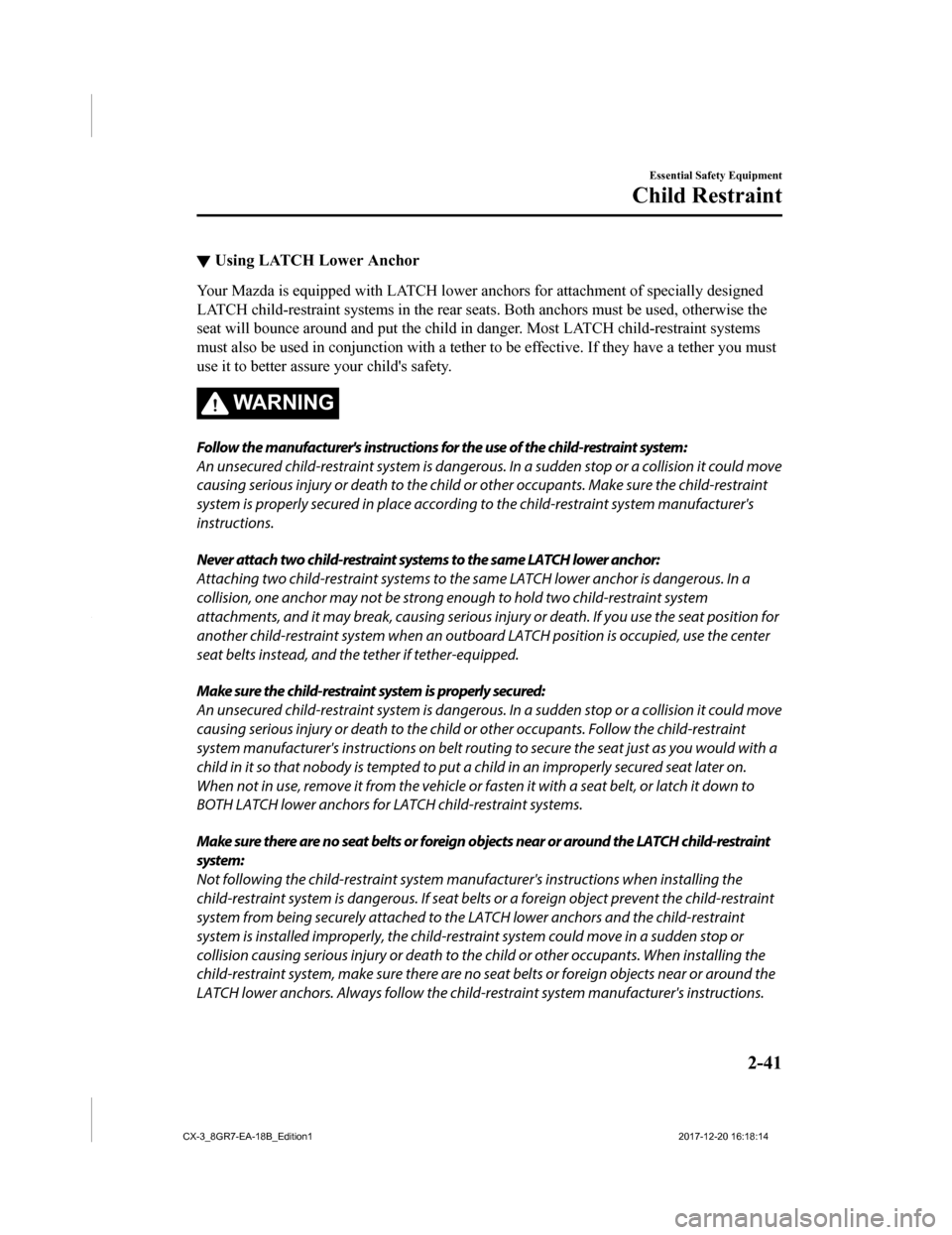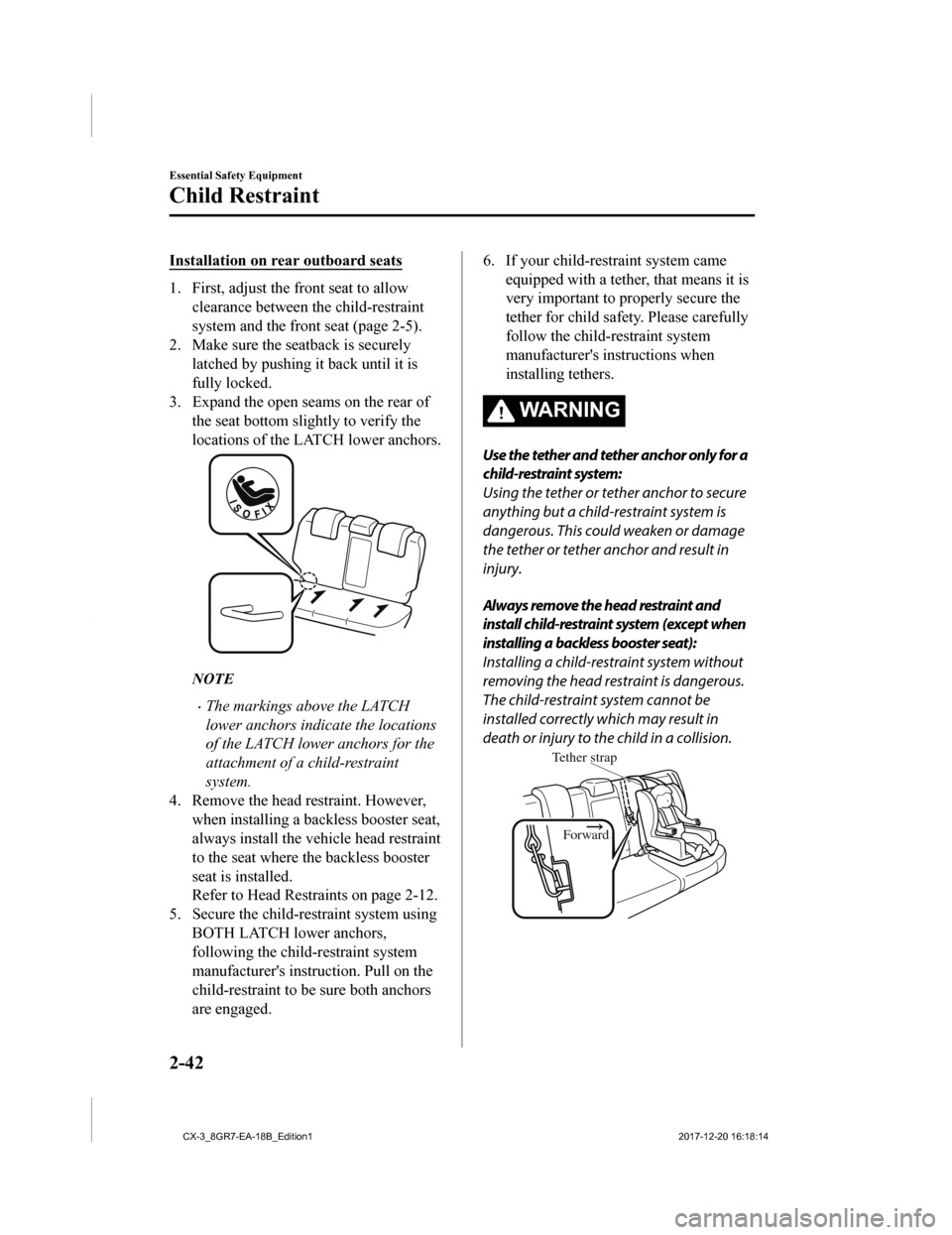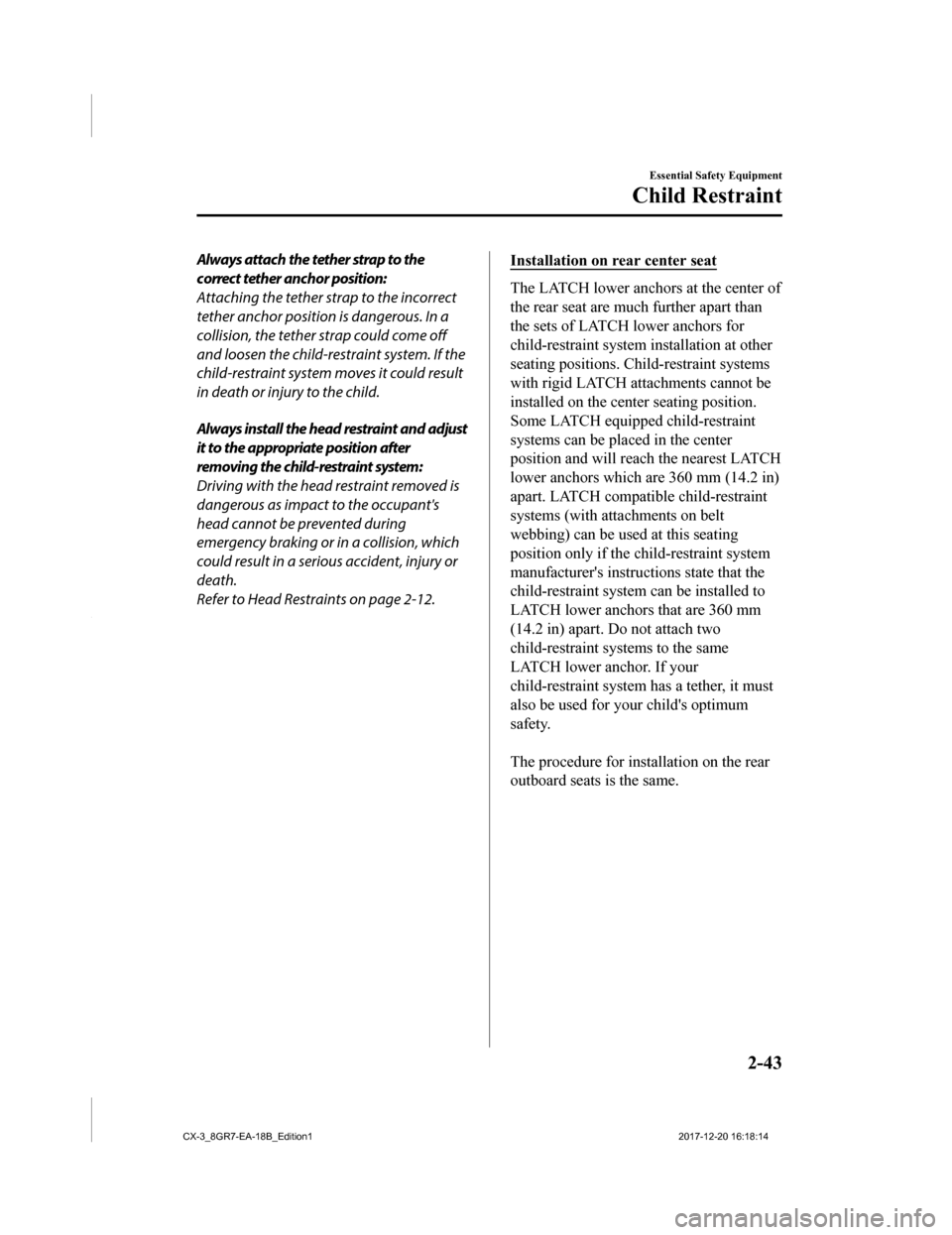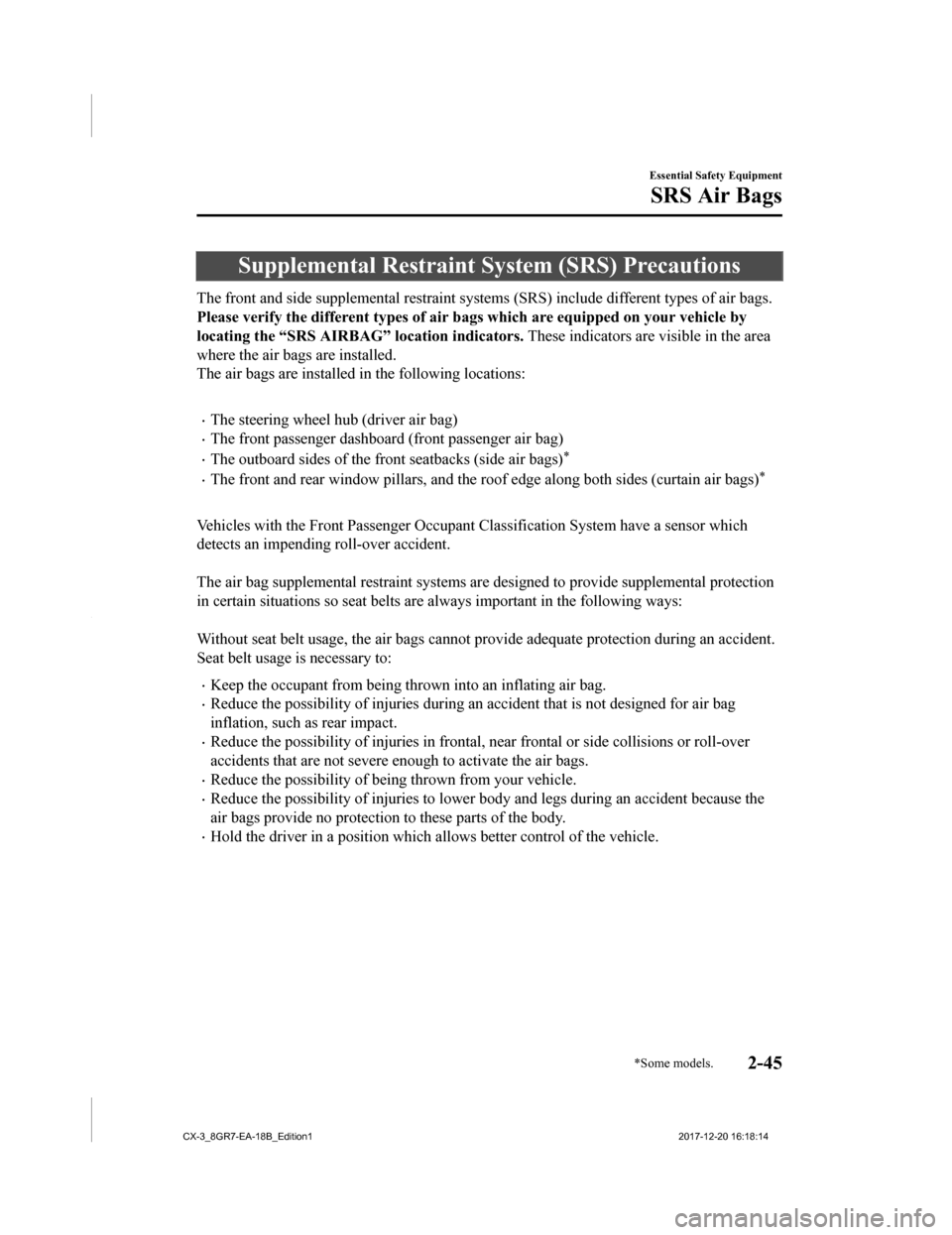MAZDA MODEL CX-3 2019 (in English) Workshop Manual
Manufacturer: MAZDA, Model Year: 2019, Model line: MODEL CX-3, Model: MAZDA MODEL CX-3 2019Pages: 608, PDF Size: 7.89 MB
Page 51 of 608

4. Place the child-restraint system on theseat without putti ng your weight on the
seat and fasten the seat belt. See the
manufacturer's instructions on the
child-restraint system for belt routing
instructions.
5. To get the retractor into the automatic locking mode, pull the shoulder belt
portion of the seat belt until the entire
length of the belt is out of the retractor.
6. Push the child-restraint system firmly
into the vehicle seat. Be sure the belt
retracts as snugly as possible. A
clicking noise from the retractor will
be heard during retraction if the system
is in automatic locking mode. If the
belt does not lock the seat down tight,
repeat the previous step and also this
one.
NOTE
•Inspect this function before each use
of the child-rest raint system. You
should not be able to pull the
shoulder belt out of the retractor
while the system is in the automatic
locking mode. When you remove the
child-restraint system, be sure the
belt fully retracts to return the
system to emergency locking mode
before occupants use the seat belts.
•Follow the child- restraint system
manufacturer's instructions
carefully.
Depending on the type of
child-restraint sy stem, it may not
employ seat belts which are in
automatic locking mode.
7. Seat your child safely in the child-restraint system and secure the
child according to the instructions
from the child-restraint system
manufacturer.
8. Switch the ignition ON and make sure the front passenger air bag deactivation
indicator light illuminates after
installing a child-restraint system on
the front passenger seat.
If the front passenger air bag
deactivation indicator light does not
illuminate, remove the child-restraint
system, switch the i gnition to OFF, and
then re-install th e child-restraint
system (page 2-61).
Essential Safety Equipment
Child Restraint
2-39
CX-3_8GR7-EA-18B_Edition1 2017-12-20 16:18:14
Page 52 of 608

WA R N I N G
Do not seat a child in a child-restraint
system on the front passenger seat if the
front passenger air bag deactivation
indicator light does not illuminate:
While it is always better to install any
child-restraint system on the rear seat, it is
imperative that a child-restraint system
ONLY be used on the front passenger seat if
the deactivation indicator light illuminates
when the child is seated in the
child-restraint system (page 2-61). Seating
a child in a child-restraint system installed
on the front passenger seat with the front
passenger air bag deactivation indicator
light not illuminated is dangerous. If this
indicator light does not illuminate, this
means that the front passenger front and
side air bags, and seat belt pretensioner are
ready for deployment. If an accident were
to deploy an air bag, a child in a
child-restraint system sitting in the front
passenger seat could be seriously injured or
killed. If the indicator light does not
illuminate after seating a child in a
child-restraint system on the front
passenger seat, seat a child in a
child-restraint system on the rear seat and
consult an Authorized Mazda Dealer as
soon as possible.
Essential Safety Equipment
Child Restraint
2-40
CX-3_8GR7-EA-18B_Edition1 2017-12-20 16:18:14
Page 53 of 608

▼Using LATCH Lower Anchor
Your Mazda is equipped with LATCH lower anchors for attachment
of specially designed
LATCH child-restraint systems in the rear seats. Both anchors must be used, otherwise the
seat will bounce around and put the child in danger. Most LATCH child-restraint systems
must also be used in conjunction with a tether to be effective. If they have a tether you must
use it to better assure your child's safety.
WA R N I N G
Follow the manufacturer's instructions for the use of the child-restraint system:
An unsecured child-restraint system is dangerous . In a sudden stop or a collision it could move
causing serious injury or death to the child or other occupants. Make sure the child-restraint
system is properly secured in place accordin g to the child-restraint system manufacturer's
instructions.
Never attach two child-restraint systems to the same LATCH lower anchor:
Attaching two child-restraint systems to the same LATCH lower anchor is dangerous. In a
collision, one anchor may not be strong enough to hold two child-restraint system
attachments, and it may break, causing serious inju ry or death. If you use the seat position for
another child-restraint system when an outboar d LATCH position is occupied, use the center
seat belts instead, and the tether if tether-equipped.
Make sure the child-restraint system is properly secured:
An unsecured child-restraint system is dangerous . In a sudden stop or a collision it could move
causing serious injury or death to the child or other occupants. Follow the child-restraint
system manufacturer's instructions on belt routin g to secure the seat just as you would with a
child in it so that nobody is tempted to put a child in an improperly secured seat later on.
When not in use, remove it from the vehicle or fasten it with a seat belt, or latch it down to
BOTH LATCH lower anchors for LATCH child-restraint systems.
Make sure there are no seat belts or foreign objects near or around the LATCH child-restraint
system:
Not following the child-restraint system manu facturer's instructions when installing the
child-restraint system is dangerous. If seat be lts or a foreign object prevent the child-restraint
system from being securely attached to the LATCH lower anchors and the child-restraint
system is installed improperly, the child-restr aint system could move in a sudden stop or
collision causing serious injury or death to th e child or other occupants. When installing the
child-restraint system, make sure there are no seat belts or foreign objects near or around the
LATCH lower anchors. Always follow the child- restraint system manufacturer's instructions.
Essential Safety Equipment
Child Restraint
2-41
CX-3_8GR7-EA-18B_Edition1 2017-12-20 16:18:14
Page 54 of 608

Installation on rear outboard seats
1. First, adjust the front seat to allowclearance between the child-restraint
system and the front seat (page 2-5).
2. Make sure the seatback is securely
latched by pushing it back until it is
fully locked.
3. Expand the open seams on the rear of
the seat bottom slig htly to verify the
locations of the LATCH lower anchors.
NOTE
•The markings above the LATCH
lower anchors indicate the locations
of the LATCH lower anchors for the
attachment of a child-restraint
system.
4. Remove the head restraint. However,
when installing a backless booster seat,
always install the vehicle head restraint
to the seat where the backless booster
seat is installed.
Refer to Head Restra ints on page 2-12.
5. Secure the child-restraint system using BOTH LATCH lower anchors,
following the child-restraint system
manufacturer's instruction. Pull on the
child-restraint to be sure both anchors
are engaged.
6. If your child-restraint system came
equipped with a tether, that means it is
very important to properly secure the
tether for child safety. Please carefully
follow the child-restraint system
manufacturer's instructions when
installing tethers.
WA R N I N G
Use the tether and tether anchor only for a
child-restraint system:
Using the tether or tether anchor to secure
anything but a child-restraint system is
dangerous. This could weaken or damage
the tether or tether anchor and result in
injury.
Always remove the head restraint and
install child-restraint system (except when
installing a backless booster seat):
Installing a child-restraint system without
removing the head restraint is dangerous.
The child-restraint system cannot be
installed correctly which may result in
death or injury to the child in a collision.
Tether strap
Forward
Essential Safety Equipment
Child Restraint
2-42
CX-3_8GR7-EA-18B_Edition1 2017-12-20 16:18:14
Page 55 of 608

Always attach the tether strap to the
correct tether anchor position:
Attaching the tether strap to the incorrect
tether anchor position is dangerous. In a
collision, the tether strap could come off
and loosen the child-restraint system. If the
child-restraint system moves it could result
in death or injury to the child.
Always install the head restraint and adjust
it to the appropriate position after
removing the child-restraint system:
Driving with the head restraint removed is
dangerous as impact to the occupant's
head cannot be prevented during
emergency braking or in a collision, which
could result in a serious accident, injury or
death.
Refer to Head Restraints on page 2-12.
Installation on rear center seat
The LATCH lower anchors at the center of
the rear seat are much further apart than
the sets of LATCH lower anchors for
child-restraint system installation at other
seating positions. Child-restraint systems
with rigid LATCH attachments cannot be
installed on the center seating position.
Some LATCH equipped child-restraint
systems can be placed in the center
position and will reach the nearest LATCH
lower anchors which are 360 mm (14.2 in)
apart. LATCH compatib le child-restraint
systems (with attachments on belt
webbing) can be used at this seating
position only if the c hild-restraint system
manufacturer's instructions state that the
child-restraint system can be installed to
LATCH lower anchor s that are 360 mm
(14.2 in) apart. Do not attach two
child-restraint sy stems to the same
LATCH lower anchor. If your
child-restraint system has a tether, it must
also be used for your child's optimum
safety.
The procedure for installation on the rear
outboard seats is the same.
Essential Safety Equipment
Child Restraint
2-43
CX-3_8GR7-EA-18B_Edition1 2017-12-20 16:18:14
Page 56 of 608

LATCH lower anchor location
WA R N I N G
Always remove the head restraint and
install child-restraint system (except when
installing a backless booster seat):
Installing a child-restraint system without
removing the head restraint is dangerous.
The child-restraint system cannot be
installed correctly which may result in
death or injury to the child in a collision.
Tether strap
Forward
Always attach the tether strap to the
correct tether anchor position:
Attaching the tether strap to the incorrect
tether anchor position is dangerous. In a
collision, the tether strap could come off
and loosen the child-restraint system. If the
child-restraint system moves it could result
in death or injury to the child.
Always install the head restraint and adjust
it to the appropriate position after
removing the child-restraint system:
Driving with the head restraint removed is
dangerous as impact to the occupant's
head cannot be prevented during
emergency braking or in a collision, which
could result in a serious accident, injury or
death.
Refer to Head Restraints on page 2-12.
Essential Safety Equipment
Child Restraint
2-44
CX-3_8GR7-EA-18B_Edition1 2017-12-20 16:18:14
Page 57 of 608

Supplemental Restraint System (SRS) Precautions
The front and side supplemental restraint systems (SRS) include different types of air bags.
Please verify the different types of air bags which are equippe d on your vehicle by
locating the “SRS AIRBAG ” location indicators. These indicators are visible in the area
where the air bags are installed.
The air bags are installed i n the following locations:
•The steering wheel hub (driver air bag)
•The front passenger dashboard (front passenger air bag)
•The outboard sides of the fron t seatbacks (side air bags)*
•The front and rear window pillar s, and the roof edge along both sides (curtain air bags)*
Vehicles with the Front Passenger Occupant Classification Syste m have a sensor which
detects an impending roll-over accident.
The air bag supplemental restraint systems are designed to prov ide supplemental protection
in certain situations so seat belts are always important in the following ways:
Without seat belt usage, the air bags cannot provide adequate p rotection during an accident.
Seat belt usage is necessary to:
•Keep the occupant from being thrown into an inflating air bag.
•Reduce the possibility of injuri es during an accident that is not designed for air bag
inflation, such as rear impact.
•Reduce the possibility of inju ries in frontal, near frontal or side collisions or roll-over
accidents that are not severe enough to activate the air bags.
•Reduce the possibility of being thrown from your vehicle.
•Reduce the possibility of injuries to lower body and legs durin g an accident because the
air bags provide no protection to these parts of the body.
•Hold the driver in a position whic h allows better control of the vehicle.
Essential Safety Equipment
SRS Air Bags
*Some models.2-45
CX-3_8GR7-EA-18B_Edition1 2017-12-20 16:18:14
Page 58 of 608

If your vehicle is also equipped with a front passenger occupant classification system,
refer to the Front Passenger O ccupant Classification System (pa ge 2-61) for details.
If your vehicle is equipped with a front passenger occupant cla ssification system, the front
passenger air bag deactivation indicator light illuminates for a specified time after the
ignition is switched ON.
Small children must be protected by a child-restraint system as stipulated by law in every
state and province. In certain states and provinces, larger chi ldren must use a child-restraint
system (page 2-23).
Carefully consider whic h child-restraint system is necessary fo r your child and follow the
installation directions in this Owner's Manual as well as the c hild-restraint system
manufacturer's instructions.
WA R N I N G
Seat belts must be worn in air bag equipped vehicles:
Depending only on the air bags for protection during an accident is dangerous. Alone, air
bags may not prevent serious injuries. The appr opriate air bags can be expected to inflate
only in the first accident, such as frontal, near frontal or side collision s or roll-over accidents
that are at least moderate. Vehicle occu pants should always wear seat belts.
Children should not ride in the front passenger seat:
Placing a child, 12 years or under, in the front seat is dangerous. The child could be hit by a
deploying air bag and be seriously injured or even killed. A sleeping child is more likely to lean
against the door and be hit by the side air ba g in moderate collision to the front-passenger
side of the vehicle. Whenever possible, always secure a child 12 years and under on the rear
seats with an appropriate child-restrain t system for the child's age and size.
Essential Safety Equipment
SRS Air Bags
2-46
CX-3_8GR7-EA-18B_Edition1 2017-12-20 16:18:14
Page 59 of 608

Never use a rear-facing child-restraint system in the front seat with an air bag that could
deploy:
Rear-facing child-restraint systems on the front seat are particularly dangerous even though
you may feel assured that a front passenger air bag will not deploy based on the fact that the
front passenger air bag deactivation indicator light illuminates. The child-restraint system
can be hit by a deploying air bag and moved viol ently backward resulting in serious injury or
death to the child.
Do not sit too close to the driver and front passenger air bags:
Sitting too close to the driver and front passenger air bag modules or placing hands or feet on
them is extremely dangerous. The driver and front passenger air bags inflate with great force
and speed. Serious injuries could occur if someon e is too close. The driver should always hold
onto only the rim of the steering wheel. The front seat passenger should keep both feet on the
floor. Front seat occupants should adjust their seats as far back as possible and always sit
upright against the seatbacks with seat belts worn properly.
Sit in the center of the seat and wear seat belts properly:
Sitting too close to the side air bag modules or placing hands on them, or sleeping up against
the door or hanging out the windows is extrem ely dangerous. The side and curtain air bags
inflate with great force and speed directly expanding
along the door on the side the car is hit.
Serious injury could occur if someone is sitting too close to the door or leaning against a
window, or if rear seat occupants grab the side s of the front seatbacks. Give the side and
curtain air bags room to work by sitting in th e center of the seat while the vehicle is moving
with seat belts worn properly.
Do not attach objects on or around the area where driver and front passenger air bags
deploy:
Attaching an object to the driver and front passenger air bag modules or placing something
in front of them is dangerous. In an acci dent, an object could interfere with air bag
inflation
and injure the occupants.
Essential Safety Equipment
SRS Air Bags
2-47
CX-3_8GR7-EA-18B_Edition1 2017-12-20 16:18:14
Page 60 of 608

Do not attach objects on or around the area where a side air bag deploys:
Attaching objects to the front seat in such a way as to cover the outboard side of the seat in
any way is dangerous. In an accident the object could interfere with the side air bag, which
inflates from the outboard side of the front seat s, impeding the added protection of the side
air bag system or redirecting the air bag in a way that is dangerous. Furthermore, the bag
could be cut open releasing the gas.
Do not hang net bags, map pouches or backpacks with side straps on the front seats. Never
use seat covers on the front seats. Always keep the side air bag modules in your front seats
free to deploy in the event of a side collision.
Do not attach objects on or around the area where a curtain air bag deploys:
Attaching objects to the areas where the curtai n air bag activates such as on the windshield
glass, side door glass, front and rear window pi llars and along the roof edge and assist grips is
dangerous. In an accident the object could interfere with the curtain air bag, which
inflates
from the front and rear window pillars and along the roof edge, impeding the added
protection of the curtain air bag system or redir ecting the air bag in a way that is dangerous.
Furthermore, the bag could be cut open releasing the gas.
Do not place hangers or any other objects on the assist grips. When hanging clothes, hang
them on the coat hook directly. Always keep th e curtain air bag modules free to deploy in the
event of a side collision or roll-over accident.
Do not touch the components of the supplemental restraint system after the air bags have
inflated:
Touching the components of the supplemental restraint system after the air bags have
inflated is dangerous. Immediately after inflation, they are very hot. You could get burned.
Never install any front-end equipment to your vehicle:
Installation of front-end equipment, such as frontal protection bar (kangaroo bar, bull bar,
push bar, or other similar devices), snowplow , or winches, is dangerous. The air bag crash
sensor system could be affected. This could cause air bags to
inflate unexpectedly, or it could
prevent the air bags from inflating during an accident. Front occupants could be seriously
injured.
Do not modify the suspension:
Modifying the vehicle suspension is dangerous. If the vehicle's height or the suspension is
modified, the vehicle will be unable to accura tely detect a collision or roll-over accident
resulting in incorrect or unexpected air bag depl oyment and the possibility of serious injuries.
Essential Safety Equipment
SRS Air Bags
2-48
CX-3_8GR7-EA-18B_Edition1 2017-12-20 16:18:14